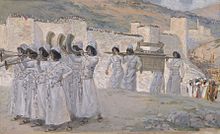Hakkafot
As Hakkafot or Hakafot ( Hebrew הַקָפוֹת, German "Umzüge", singular Hakafah) are used in the Jewish liturgy and in Jewish customs to refer to ceremonial interactions . Common to the Hakkafot is the number seven , which is mystical in the Jewish tradition, and a “ magic circle ”. Best known are the in Joshua described multiple orbits of the city of Jericho by the Israelites under trombone sounds as an act of war and since the Middle Ages held Hakkafot with the Torah scrolls on Torafreudenfest Simchat Torah .
Hebrew Bible
In the Hebrew Bible , Hakkafot is described as a warlike event in the Book of Joshua ( ELB ). In the biblical representation, the Israelites who had emigrated from Egypt walked around with the Ark of the Covenant once for six days; on the seventh day, however, seven times around the city of Jericho, which was surrounded by a wall, blew their rams' horn as much as they could and brought the walls to collapse, which meant they had conquered the city made possible.
Mishnah
The Mishnah ( Sukkah 3:12) mentions ceremonial walkings with branches and fruits, the lulav , around the altar in the Jerusalem temple during the seven days of the pilgrimage festival of Sukkot .
liturgy
Although the Hakkafot are not recorded during the Sukkot festival for the time after the destruction of the Second Temple , they have been preserved in the Sukkot liturgy. On the first six days of the festival, except on the Sabbath , in the synagogue during the morning service there is a meeting with Lulav and Etrog around the lectern, the Almemor , on Hoschana Rabba , the seventh and last day of the festival, the procession is seven Times repeated.
Since the Middle Ages, Hakkafot has been taking place on the Simchat Torah celebration of the Torah , which in Israel and reform communities falls on the day after Sukkot, Schemini Azeret , and in the rest of the Jewish communities on the day after, usually both during the evening and morning prayers . On this occasion, all Torah scrolls are fetched from the Torah shrine and carried in procession seven times around the Almemor or through the synagogue. Many religious Jews of all denominations , especially the Hasidic ones , extend this procession if possible and dance with the Torah scrolls. In Orthodox communities only men take part in the Hakkafot, in numerous conservative and liberal and in all reconstructionist and reform communities women and men take part in the Hakkafot together.
Seven Hakkafots are also performed at the inauguration of synagogues and Jewish cemeteries.
regional customs
- Funeral hakkafot
Sephardic , Hasidic and Yemeni Jews know the custom of funeral hakkafot, in which the mourners step around the bier seven times before the deceased is buried.
- Wedding shakkafot
In many Jewish communities it is customary for the bride to circle the groom seven times, sometimes three times during the wedding ceremony.
common ground
The Hakkafot in liturgy and customs have in common that they contain the mystical number seven and with them a “magic” circle is drawn. In the custom, a keeping away from "evil spirits" should be intended.
Individual evidence
- ↑ Ismar Elbogen : Hakkafot . In: Jewish Lexicon . tape 2 . Berlin 1927, p. 1350 ( online [accessed December 6, 2012]).
- ↑ a b c d e f g Harry Rabinowicz, Rela M. Geffen: Hakkafot . In: Michael Berenbaum, Fred Skolnik (Ed.): Encyclopaedia Judaica . 2nd Edition. tape 8 . Macmillan Reference USA, Detroit 2007, pp. 250 ( online: Gale Virtual Reference Library ).
- ↑ Aaron Rothkoff, Shalom Sabar: Simhat Torah . In: Michael Berenbaum, Fred Skolnik (Ed.): Encyclopaedia Judaica . 2nd Edition. tape 18 . Macmillan Reference USA, Detroit 2007, pp. 604-606 ( online: Gale Virtual Reference Library ).
- ^ Delbert Roy Hillers, Reuben Kashani: Burial . In: Michael Berenbaum, Fred Skolnik (Ed.): Encyclopaedia Judaica . 2nd Edition. tape 4 . Macmillan Reference USA, Detroit 2007, pp. 604-606 ( online: Gale Virtual Reference Library ).

